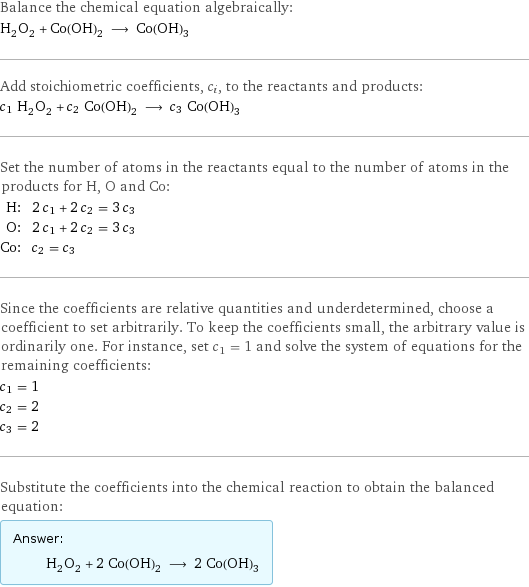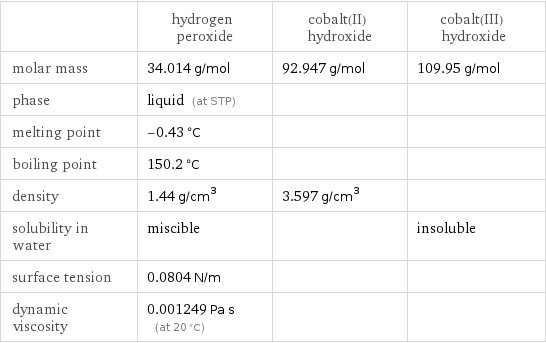Input interpretation

H_2O_2 hydrogen peroxide + Co(OH)_2 cobalt(II) hydroxide ⟶ Co(OH)_3 cobalt(III) hydroxide
Balanced equation

Balance the chemical equation algebraically: H_2O_2 + Co(OH)_2 ⟶ Co(OH)_3 Add stoichiometric coefficients, c_i, to the reactants and products: c_1 H_2O_2 + c_2 Co(OH)_2 ⟶ c_3 Co(OH)_3 Set the number of atoms in the reactants equal to the number of atoms in the products for H, O and Co: H: | 2 c_1 + 2 c_2 = 3 c_3 O: | 2 c_1 + 2 c_2 = 3 c_3 Co: | c_2 = c_3 Since the coefficients are relative quantities and underdetermined, choose a coefficient to set arbitrarily. To keep the coefficients small, the arbitrary value is ordinarily one. For instance, set c_1 = 1 and solve the system of equations for the remaining coefficients: c_1 = 1 c_2 = 2 c_3 = 2 Substitute the coefficients into the chemical reaction to obtain the balanced equation: Answer: | | H_2O_2 + 2 Co(OH)_2 ⟶ 2 Co(OH)_3
Structures

+ ⟶
Names

hydrogen peroxide + cobalt(II) hydroxide ⟶ cobalt(III) hydroxide
Equilibrium constant
![Construct the equilibrium constant, K, expression for: H_2O_2 + Co(OH)_2 ⟶ Co(OH)_3 Plan: • Balance the chemical equation. • Determine the stoichiometric numbers. • Assemble the activity expression for each chemical species. • Use the activity expressions to build the equilibrium constant expression. Write the balanced chemical equation: H_2O_2 + 2 Co(OH)_2 ⟶ 2 Co(OH)_3 Assign stoichiometric numbers, ν_i, using the stoichiometric coefficients, c_i, from the balanced chemical equation in the following manner: ν_i = -c_i for reactants and ν_i = c_i for products: chemical species | c_i | ν_i H_2O_2 | 1 | -1 Co(OH)_2 | 2 | -2 Co(OH)_3 | 2 | 2 Assemble the activity expressions accounting for the state of matter and ν_i: chemical species | c_i | ν_i | activity expression H_2O_2 | 1 | -1 | ([H2O2])^(-1) Co(OH)_2 | 2 | -2 | ([Co(OH)2])^(-2) Co(OH)_3 | 2 | 2 | ([Co(OH)3])^2 The equilibrium constant symbol in the concentration basis is: K_c Mulitply the activity expressions to arrive at the K_c expression: Answer: | | K_c = ([H2O2])^(-1) ([Co(OH)2])^(-2) ([Co(OH)3])^2 = ([Co(OH)3])^2/([H2O2] ([Co(OH)2])^2)](../image_source/1a4b194dfc8c08ee145b7484d6462247.png)
Construct the equilibrium constant, K, expression for: H_2O_2 + Co(OH)_2 ⟶ Co(OH)_3 Plan: • Balance the chemical equation. • Determine the stoichiometric numbers. • Assemble the activity expression for each chemical species. • Use the activity expressions to build the equilibrium constant expression. Write the balanced chemical equation: H_2O_2 + 2 Co(OH)_2 ⟶ 2 Co(OH)_3 Assign stoichiometric numbers, ν_i, using the stoichiometric coefficients, c_i, from the balanced chemical equation in the following manner: ν_i = -c_i for reactants and ν_i = c_i for products: chemical species | c_i | ν_i H_2O_2 | 1 | -1 Co(OH)_2 | 2 | -2 Co(OH)_3 | 2 | 2 Assemble the activity expressions accounting for the state of matter and ν_i: chemical species | c_i | ν_i | activity expression H_2O_2 | 1 | -1 | ([H2O2])^(-1) Co(OH)_2 | 2 | -2 | ([Co(OH)2])^(-2) Co(OH)_3 | 2 | 2 | ([Co(OH)3])^2 The equilibrium constant symbol in the concentration basis is: K_c Mulitply the activity expressions to arrive at the K_c expression: Answer: | | K_c = ([H2O2])^(-1) ([Co(OH)2])^(-2) ([Co(OH)3])^2 = ([Co(OH)3])^2/([H2O2] ([Co(OH)2])^2)
Rate of reaction
![Construct the rate of reaction expression for: H_2O_2 + Co(OH)_2 ⟶ Co(OH)_3 Plan: • Balance the chemical equation. • Determine the stoichiometric numbers. • Assemble the rate term for each chemical species. • Write the rate of reaction expression. Write the balanced chemical equation: H_2O_2 + 2 Co(OH)_2 ⟶ 2 Co(OH)_3 Assign stoichiometric numbers, ν_i, using the stoichiometric coefficients, c_i, from the balanced chemical equation in the following manner: ν_i = -c_i for reactants and ν_i = c_i for products: chemical species | c_i | ν_i H_2O_2 | 1 | -1 Co(OH)_2 | 2 | -2 Co(OH)_3 | 2 | 2 The rate term for each chemical species, B_i, is 1/ν_i(Δ[B_i])/(Δt) where [B_i] is the amount concentration and t is time: chemical species | c_i | ν_i | rate term H_2O_2 | 1 | -1 | -(Δ[H2O2])/(Δt) Co(OH)_2 | 2 | -2 | -1/2 (Δ[Co(OH)2])/(Δt) Co(OH)_3 | 2 | 2 | 1/2 (Δ[Co(OH)3])/(Δt) (for infinitesimal rate of change, replace Δ with d) Set the rate terms equal to each other to arrive at the rate expression: Answer: | | rate = -(Δ[H2O2])/(Δt) = -1/2 (Δ[Co(OH)2])/(Δt) = 1/2 (Δ[Co(OH)3])/(Δt) (assuming constant volume and no accumulation of intermediates or side products)](../image_source/dce72f416d4d4fdbcc39ab1218260b20.png)
Construct the rate of reaction expression for: H_2O_2 + Co(OH)_2 ⟶ Co(OH)_3 Plan: • Balance the chemical equation. • Determine the stoichiometric numbers. • Assemble the rate term for each chemical species. • Write the rate of reaction expression. Write the balanced chemical equation: H_2O_2 + 2 Co(OH)_2 ⟶ 2 Co(OH)_3 Assign stoichiometric numbers, ν_i, using the stoichiometric coefficients, c_i, from the balanced chemical equation in the following manner: ν_i = -c_i for reactants and ν_i = c_i for products: chemical species | c_i | ν_i H_2O_2 | 1 | -1 Co(OH)_2 | 2 | -2 Co(OH)_3 | 2 | 2 The rate term for each chemical species, B_i, is 1/ν_i(Δ[B_i])/(Δt) where [B_i] is the amount concentration and t is time: chemical species | c_i | ν_i | rate term H_2O_2 | 1 | -1 | -(Δ[H2O2])/(Δt) Co(OH)_2 | 2 | -2 | -1/2 (Δ[Co(OH)2])/(Δt) Co(OH)_3 | 2 | 2 | 1/2 (Δ[Co(OH)3])/(Δt) (for infinitesimal rate of change, replace Δ with d) Set the rate terms equal to each other to arrive at the rate expression: Answer: | | rate = -(Δ[H2O2])/(Δt) = -1/2 (Δ[Co(OH)2])/(Δt) = 1/2 (Δ[Co(OH)3])/(Δt) (assuming constant volume and no accumulation of intermediates or side products)
Chemical names and formulas

| hydrogen peroxide | cobalt(II) hydroxide | cobalt(III) hydroxide formula | H_2O_2 | Co(OH)_2 | Co(OH)_3 Hill formula | H_2O_2 | CoH_2O_2 | CoH_3O_3 name | hydrogen peroxide | cobalt(II) hydroxide | cobalt(III) hydroxide
Substance properties

| hydrogen peroxide | cobalt(II) hydroxide | cobalt(III) hydroxide molar mass | 34.014 g/mol | 92.947 g/mol | 109.95 g/mol phase | liquid (at STP) | | melting point | -0.43 °C | | boiling point | 150.2 °C | | density | 1.44 g/cm^3 | 3.597 g/cm^3 | solubility in water | miscible | | insoluble surface tension | 0.0804 N/m | | dynamic viscosity | 0.001249 Pa s (at 20 °C) | |
Units
